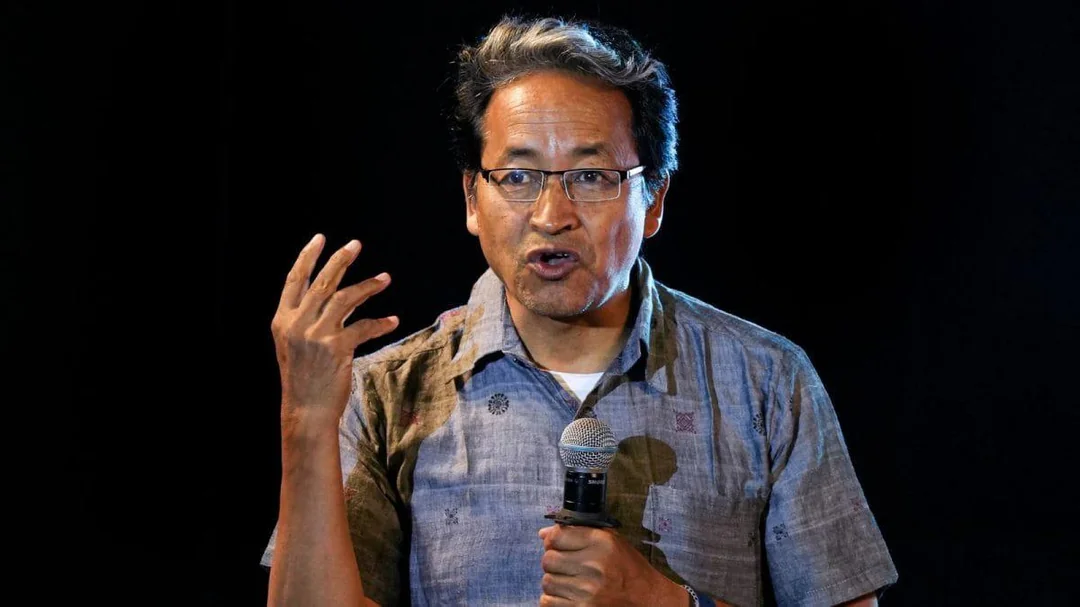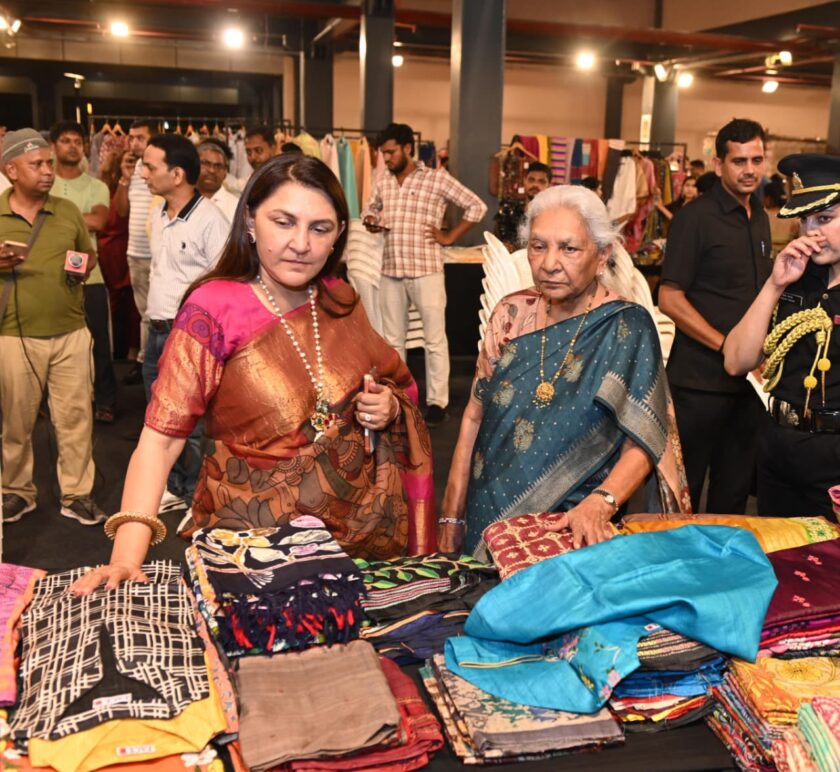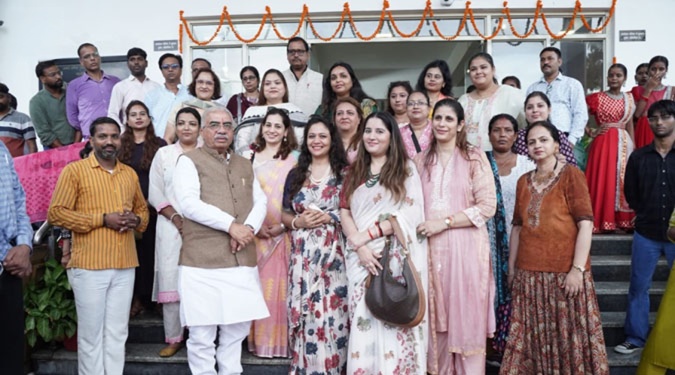Ladakh: In the shadow of the world’s highest mountain range, where the air is thin and the earth cracks under the weight of silence, one man’s life has become a beacon of what it means to innovate, resist, and rebuild. Sonam Wangchuk—born on September 1, 1966, in the remote village of Uleytokpo near Alchi in Ladakh—embodies a philosophy of grounded genius. His life’s work defies conventions, celebrating the triumph of community over individual glory, sustainability over exploitation, and quiet defiance over complacency.
At 59, Wangchuk stands as an engineer, educator, environmentalist, and activist—yet these labels only skim the surface of his transformative journey. His story, whispered from the frozen stupas of the Himalayas to global climate conferences, reminds the world that innovation without empathy is hollow. His is a tale of one man who chose to think locally, act globally, and remain ethically unshaken even as the earth beneath his homeland shifts—literally and politically.
Forged in Adversity
Wangchuk’s childhood was a masterclass in adversity. Growing up in Ladakh—a high-altitude cold desert at over 3,000 meters—meant that formal schooling was a luxury. Until the age of nine, he learned at home from his mother, Tsering Wangmo, absorbing the rhythms of Ladakhi folklore, Buddhist teachings, and the art of surviving amidst glacial winds. His father, Sonam Wangyal, a prominent politician who became a minister in 1975, later moved the family to Srinagar.
But urban schooling was a different kind of battle. Enrolled in a Kendriya Vidyalaya, young Wangchuk found himself adrift in a sea of Hindi, English, and Urdu—languages foreign to his Ladakhi roots. “I was a dumb boy from Ladakh,” he once said, recalling how teachers mistook his silence for ignorance. This was no isolated pain. In the 1980s, Ladakh’s education system had a 5% pass rate in Class 10 exams, crippled by a curriculum that ignored the region’s culture, language, and climate.
From Humiliation to Hope
When Wangchuk graduated from the National Institute of Technology (NIT), Srinagar, in 1988 with a degree in Mechanical Engineering, he could have pursued comfort elsewhere. Instead, he turned his struggle into purpose. Along with his brothers and five peers, he co-founded the Students’ Educational and Cultural Movement of Ladakh (SECMOL)—an experiment in reimagining education.
Unlike traditional schools, SECMOL welcomed failures. Students who had flunked exams found acceptance, learning through practice rather than punishment. The campus, built from mud and earth, was designed using solar principles—staying +15°C indoors even when the outside temperature dipped to -15°C. This architectural innovation later won the 2016 Terra Award for the World’s Best Earth Buildings.
The success of SECMOL wasn’t confined to walls of adobe and sunlight. In 1994, Wangchuk spearheaded Operation New Hope—a collaboration between the government, local communities, and NGOs. By integrating child-friendly teaching methods and revising curricula to reflect Ladakh’s ecology and culture, the region’s Class 10 pass rate soared from 5% to 75% within a decade.
This was more than an academic reform—it was a cultural renaissance. Education became a tool of empowerment rather than alienation. Wangchuk’s vision turned schools into living laboratories of self-reliance, producing not just literate minds but resilient citizens.
Engineering with a Soul
Sonam Wangchuk’s creativity transcended classrooms. As global warming began melting the Himalayan glaciers at alarming rates, Ladakh faced severe water crises during the sowing season. Wangchuk responded not with despair but design. In 2013, he introduced the Ice Stupa—cone-shaped artificial glaciers that store water in winter and release it gradually during summer.
Each stupa, built using gravity-fed pipes that spray water into sub-zero air, can hold up to 150,000 liters—providing crucial irrigation to desert farmlands. These elegant ice sculptures, inspired by Buddhist stupas, soon caught the world’s imagination. By 2025, Ice Stupas have been replicated in Mongolia, Switzerland, and Chile, earning Wangchuk the Rolex Award for Enterprise.
Yet he never sought to patent or commercialize his creation. “Innovation must serve the soil it’s born from,” he insists. His designs are open-source, freely shared with anyone willing to adapt them for their ecosystems. It is innovation, not for applause—but for survival.
The Himalayan Vanguard
Beyond inventions, Wangchuk’s environmental mission expanded into systemic reform. In 2019, he founded the Himalayan Institute of Alternatives, Ladakh (HIAL)—a university that merges engineering with ecology and entrepreneurship. Here, students build sustainable homes, design water-harvesting systems, and run FarmStays Ladakh, a community tourism initiative that directs profits to local families.
HIAL stands as a blueprint for education that addresses the 21st century’s most urgent crises—climate change, cultural erosion, and rural depopulation. “The Himalayas are the barometers of our planet,” Wangchuk often says. “If they fail, we all fail.”
His philosophy, rooted in Buddhist moderation, finds resonance in a world driven by excess. As the United Nations warns of approaching ecological tipping points, Wangchuk’s work demonstrates that technology need not alienate; it can heal when guided by empathy and ethics.
From Educator to Activist
The second act of Wangchuk’s life unfolded in the crucible of politics. Having long advised Ladakh’s Hill Council and led initiatives like the Ladakh Voluntary Network, he turned activist when Ladakh’s special status under Article 370 was revoked in 2019. With it vanished crucial safeguards for local land, jobs, and culture.
In 2013, he had already founded the New Ladakh Movement (NLM)—a green political platform advocating sustainable development. Post-2019, it evolved into a vehicle for protest. When government decisions began marginalizing local voices, Wangchuk fasted, marched, and mobilized thousands, demanding constitutional protection and statehood.

By 2025, these movements intensified after the cancellation of SECMOL’s FCRA license and revocation of land allotments. In September, protests in Leh escalated, leading to clashes that left four dead. Wangchuk was detained under the National Security Act (NSA)—a law allowing two years of imprisonment without trial.
“A Wangchuk in jail may cause more problems than a free one,” he reportedly quipped, refusing to bow. His incarceration sparked solidarity rallies across India and abroad, framing him not just as an activist, but as a moral compass in an era of repression.
The Man Behind the Myth
Ironically, global fame first found him through fiction. Wangchuk inspired Aamir Khan’s character Phunsukh Wangdu in the 2009 Bollywood film 3 Idiots. While the film romanticized the maverick inventor, the real Wangchuk remains understated—living simply in Leh, dedicating his modest income to community projects.
His recognition list is long: Ashoka Fellowship (2002), CNN-IBN Real Heroes (2008), UNESCO Chair in Earth Architecture (2014), Ramon Magsaysay Award (2018). Yet his net worth—around ₹75 lakh—is symbolic of his commitment to a minimalistic life. He remains a teacher at heart, always urging students to “use their head, heart, and hands together.”
For him, the goal isn’t wealth or fame—it’s self-reliance, both ecological and emotional.
The Global Relevance of a Himalayan Dream
Sonam Wangchuk’s significance today stretches far beyond the Himalayas. As automation threatens livelihoods and climate change displaces millions, his blueprint—integrating local wisdom with sustainable innovation—offers an antidote to alienation.
In an increasingly fragmented world, his model of “frugal innovation” and “ethical engineering” stands as a quiet revolution. While corporations chase artificial intelligence, he teaches adaptive intelligence: the capacity to solve real-world problems using the resources at hand.
His principles could well serve as a manifesto for the Global South, where communities still struggle for voice and visibility. Wangchuk’s insistence that education, environment, and empowerment are inseparable challenges the top-down models that dominate global discourse.
He once said, “Our mountains don’t need sympathy—they need sensible science.” This clarity, born of hardship and humility, makes him not just a reformer from Ladakh, but a visionary for the planet.
A Legacy Carved in Ice and Earth
Today, as he fasts and protests for Ladakh’s rights, Sonam Wangchuk remains undeterred. His activism, rooted in love rather than anger, continues to inspire thousands. Each Ice Stupa that melts into spring water, each student who builds a solar classroom, carries forward his message: that resilience and compassion can coexist, that progress need not mean destruction.
In the stillness of the mountains, where wind sculpts silence into song, Wangchuk’s philosophy echoes—a reminder that civilization’s survival depends not on domination but on harmony.
His life’s essence lies in his refusal to separate innovation from empathy. For him, the true measure of success is not the height of invention but the depth of impact.
In a world torn between technology and tradition, Sonam Wangchuk stands as a bridge—a man who turned isolation into imagination and struggle into sustainability. His journey from a misunderstood child to a global changemaker proves that the future belongs to those who listen to the earth and learn to heal it.
From the frozen deserts of Ladakh to the crowded halls of global forums, his message endures: All is well—if we dare to make it so.






